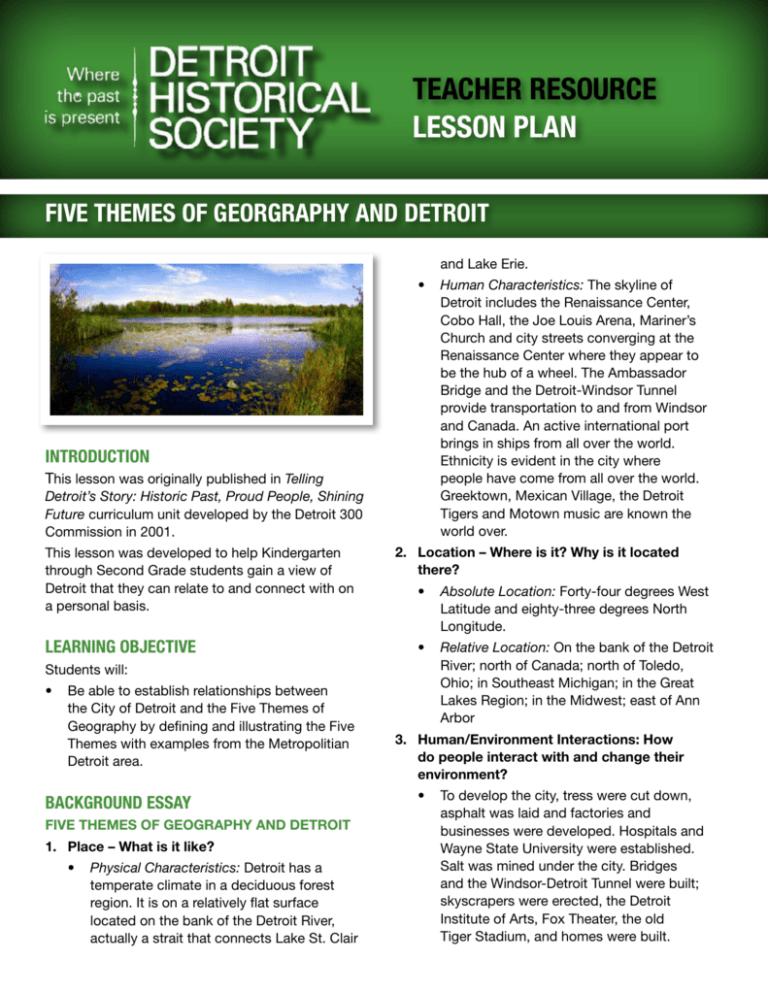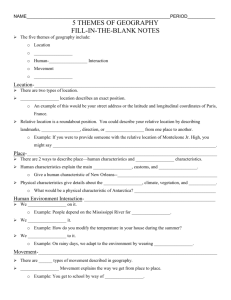teacher resource lesson plan
advertisement

TEACHER RESOURCE LESSON PLAN FIVE THEMES OF GEORGRAPHY AND DETROIT and Lake Erie. INTRODUCTION This lesson was originally published in Telling Detroit’s Story: Historic Past, Proud People, Shining Future curriculum unit developed by the Detroit 300 Commission in 2001. This lesson was developed to help Kindergarten through Second Grade students gain a view of Detroit that they can relate to and connect with on a personal basis. LEARNING OBJECTIVE Students will: • Be able to establish relationships between the City of Detroit and the Five Themes of Geography by defining and illustrating the Five Themes with examples from the Metropolitian Detroit area. BACKGROUND ESSAY FIVE THEMES OF GEOGRAPHY AND DETROIT 1. Place – What is it like? • Physical Characteristics: Detroit has a temperate climate in a deciduous forest region. It is on a relatively flat surface located on the bank of the Detroit River, actually a strait that connects Lake St. Clair • Human Characteristics: The skyline of Detroit includes the Renaissance Center, Cobo Hall, the Joe Louis Arena, Mariner’s Church and city streets converging at the Renaissance Center where they appear to be the hub of a wheel. The Ambassador Bridge and the Detroit-Windsor Tunnel provide transportation to and from Windsor and Canada. An active international port brings in ships from all over the world. Ethnicity is evident in the city where people have come from all over the world. Greektown, Mexican Village, the Detroit Tigers and Motown music are known the world over. 2. Location – Where is it? Why is it located there? • Absolute Location: Forty-four degrees West Latitude and eighty-three degrees North Longitude. • Relative Location: On the bank of the Detroit River; north of Canada; north of Toledo, Ohio; in Southeast Michigan; in the Great Lakes Region; in the Midwest; east of Ann Arbor 3. Human/Environment Interactions: How do people interact with and change their environment? • To develop the city, tress were cut down, asphalt was laid and factories and businesses were developed. Hospitals and Wayne State University were established. Salt was mined under the city. Bridges and the Windsor-Detroit Tunnel were built; skyscrapers were erected, the Detroit Institute of Arts, Fox Theater, the old Tiger Stadium, and homes were built. LESSON PLAN: 5 THEMES OF GEOGRAPHY AND DETROIT Expressways were constructed. The rivers became polluted, few trees remained, air pollution and acid rain became a hazard. Exotic species such as zebra mussels and sea lampreys were brought in on the large international ships which contaminated the Great Lakes. 4. Movement: • Through shipping and railroads, products were exported and imported from throughout the world. People moved here because of the jobs that were available. People moved away when jobs were not as plentiful, so they sought employment somewhere else. After the expressways were built, people moved to the suburbs for more space. Others moved south for warmer weather. Discuss why people come and go from this area. Do they know someone who moved here? Why? Do they know someone who moved away from here? Why? 5. Regions: • Regions could be defined by using the regions of Detroit. Detroit is in the Great Lakes region, the Southeast Michigan Region, an automobile manufacturing region, an English speaking region, a tornado region, a temperate climate region, a deciduous forest region, an urban region. It has a Detroit River region, the Mexican Village region, a Greektown region, and a downtown region. MATERIALS USED • Background Essay: “Five Themes of Geography” • Study Sheet: “Five Themes of Geography and Detroit” students write one of each of the Five Themes of Geography in each of the sections. You may wish to model this on the overhead projector or on the chalkboard. • Tell the students that we are going to use these Five Themes of Geography to describe characteristics of Detroit. Place the names of the Five Themes on a blank overhead sheet. If the students indicate that they know them, illicit definitions from the students. If it is apparent that this is new information for most of them, give the definitions. As this information is given, the teacher should fill in his/her transparency and each student should be adding to their chart by writing and/or drawing appropriate words and/or images. Developing the Activity • Now lead a discussion of each of the Five Themes using Detroit or the Metropolitian Detroit area as illustrations of each theme. As these ideas are brought up, the teacher will add the suggestions to the transparency under the correct theme. Concluding the Activity • After the students have filled in their chart on the Five Themes of Geography, give them some time in class, or assign as homework, the task of drawing a picture clue for each of the Five Themes. Extending the Activity • The teacher will place the transparency of the Five Themes of Geography and Detroit Study Sheet I on the overhead projector. Students can fill in details they may have missed during the discussion. Have the students discuss how these Five Themes can be used and applied to everyday life. • Notebook paper ASSESSING THE LEARNING LESSON SEQUENCE The pictures that the students draw will give you an indication of how well they understand the Five Themes of Geography and their applications. Opening the Activity: • Have students take out a piece of notebook paper and fold it into five sections. Have STUDY SHEET: FIVE THEMES OF GEOGRAPHY 1.Place – What is it like? • Physical Characteristics – landforms, bodies of water, plants, animals, soil, climate • Human Characteristics – culture, bridges, roads, buildings 2.Location – Where is it? Why is it located there? • Absolute Location: latitude and longitude, or an address • Relative Location – where a place is with respect to other places 3.Human/Environment Interaction – How do people interact with and change their environment? • Human Use (Resources) • Human Adaptation • Human Impact 4.Movement – How are people and places linked? • Movements – Materials and Products • Movements – People and Living Things (Migration) • Movements – Ideas and Information (Diffusion) 5.Regions – How can we generalize about the world? • Uniform Regions (Share a Physical or Human Characteristic) • Functional Regions (Share a purpose of Function) • Composite Regions (Share Several Characteristics or Functions)







